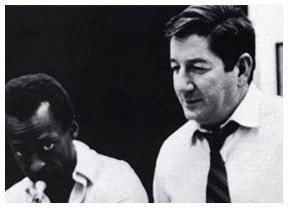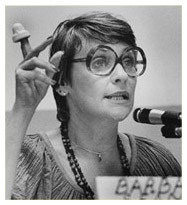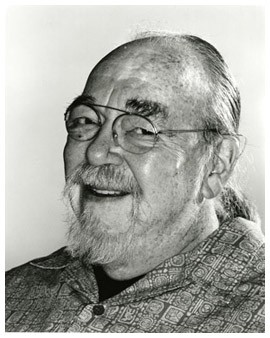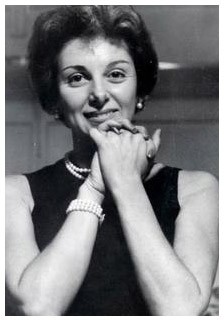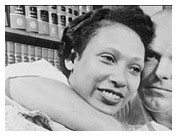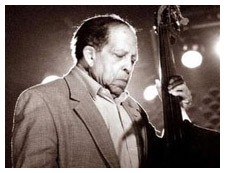;
;; ;eath took its usual toll this year, and seemingly then some. Genocide, war, terrorist attacks, disease – yikes. But for the purposes of our annual tribute to influential cultural notables whose deaths deserve a little extra note, it was a terrible harvest.;
;In addition to the loss of A-list names like Paul Newman and Heath Ledger, Studs Terkel and David Foster Wallace, Tim Russert and Jesse Helms, Isaac Hayes and Bo Diddley, the sort of semi-famous/semi-obscure folks whose passing catches our notice for possible inclusion in this roll call overwhelmed us. Yes, famous comedian Bernie Mac passed, but so did infamous comedian Rudy Ray Moore. Jimi Hendrix drummer Mitch Mitchell died, but so did Earl Palmer, whose playing formed the bedrock of almost any early rock or R&B record you care to name, and Buddy Miles, whose soulful whomp propelled the second stage of Hendrix' music.
;The list of names we could have included here is way longer than 6 feet under: raven-haired pinup Bettie Page (on the cover because, well, she's Bettie Page), exotic multi-octave diva Yma Sumac, pioneering magazine editor Clay Felker, LSD inventor Albert Hofmann, jazz clarinetist/musical explorer Jimmy Giuffre, former Indonesian dictator Suharto, '60s guru Maharishi Maresh Yogi, film critic Manny Farber, and more. Nonetheless, herein we offer accounts of some of the lives lost this year whose effect during their time here will outlast the pulp this newspaper is printed on.
;; ;Design for Living
;Victor Schreckengost
;Victor Schreckengost, who died Jan. 26 at age 101, did not have an especially famous name. But to understand his impact on the way America lives, it helps to know that he designed not only the sissy bar that kept you from sliding off the back of your banana seat while popping the wheelies of your adolescence, but also most of the old-school pedal cars that your parents drove around on the sidewalk way back when they were kids.
;Schreckengost grew up in Ohio and graduated from the Cleveland School of Art in 1929, where he went on to teach for more than 50 years. As an artist, Schreckengost is most famous for his "Jazz Bowl," blue-glazed and vibrating with lines evoking music and cities, which he designed for Eleanor Roosevelt. He's also credited with changing the face of American dinnerware, creating an American style that didn't copy its European predecessors.
;But his most lasting achievements have to do with the intersection of aesthetics and manufacture, and consequently, art and commerce. It's a dichotomy he would struggle with throughout his career, eventually reconciling in an unpublished essay: "My work has been constantly involved in the struggle between fine arts and their development into some functional form of what we call the applied or commercial arts. It took many years for me to realize that they need not conflict, that a basic philosophy, conviction, or understanding may be common to both."
;His approach to design solved a multitude of manufacturing challenges. He created the first cab-over-engine design for busses, which is used in most city busses manufactured today. He figured out efficient ways to stamp pedal car bodies out of a single sheet of metal, which by itself made them inexpensive to manufacture, but also figured out ways to use a basic body design that could be fitted with add-on details to create whole lines of toys at minimal additional cost. When General Electric charged him with designing fixtures for its fluorescent lights, he figured out that a matrix pattern cut into the panel that covers the bulb would both diffuse the light and improve the appearance of the fixture; the results still hang over heads in countless buildings. There are 109 patents to his name, and the impact of his designs on the economy is said to exceed $200 billion.
;— Michael Gill
;Unlimited ; imagination
;Alain Robbe-Grillet
;A roving camera soaks in the Old World opulence of an unnamed castle. Handsome, trim men in evening attire and jeweled women expressionlessly stare at a refined entertainment. A Chanel-clad Delphine Seyrig emerges at the top of a Rococo staircase looking like the most desirable, elegant object in the world that you're never going to be able to touch. The 1961 film Last Year at Marienbad perfectly pitches an idea of black-and-white European artiness, urbane sophistication and cold intellectual eroticism that holds to this day. And while New Wave director Alain Resnais is partly responsible for that attitude, a wealth of the movie's illogic sensibility was supplied by screenwriter Alain Robbe-Grillet, one of the leading lights of the avant-garde postwar nouveau roman who died Feb. 18 at the age of 85.;
The "new novel" was rooted in Paris' idea powder keg after World War II, when the Left Bank became a bohemian stomping ground and a youthful French generation imagined the possibilities of life after such a wretched time. A loose group of writers emerged from the publishing house Les Éditions de Minuit -– Samuel Beckett, Marguerite Duras, Robert Pinget, Nathalie Sarraute, Claude Simon – who desired to liberate the novel from the prison of Balzacian realism and forge a new style partly inspired by modernist forebears such as Faulkner, Flaubert, Joyce and Kafka. Out went causal narrative and conventional psychological probity. In came fragmented realities, repetitive structures and symbolic obsession with ritualistic, underground sexualities.
;At least, such is the world of Robbe-Grillet. Ever since the publication of his 1953 debut Les Gommes (The Erasers), he articulated in fiction, criticism, autobiography and movies his ardent beliefs in an alternative storytelling, one that strived to create a imaginative world that exists only in the artist's mind. Born in Brest in Brittany, Robbe-Grillet trained and eventually worked in botany, studying fruits and vegetables in Morocco, French Guiana, and Martinique and Guadeloupe. Writing was something he did on the side, penning his first novel in 1949 (it wasn't released until later) and turning to it full time in 1955.
;Enthusiastically admired and loathed in equal measure, Robbe-Grillet's novels –especially his later forays into the ordinary sexism of sadomasochistic play – continued to be misunderstood as purely sang-froid intellect, failing to recognize that Robbe-Grillet was as linguistically sensual as Nabokov; Robbe-Grillet just didn't indulge in the same sort of pyrotechnics. His 1960s and ‘70s novels, especially the streamlined Project for a Revolution in New York, so freed storytelling from novelistic space and time that they read as experimental movies, ordered collages of images and ideas, even though they're written in controlled, measured sentences. Robbe-Grillet found a way to write depersonalized informational sentences that created surreal, cubist alternative realities. That he didn't try to explain them away in conventional wisdom wasn't pretentious elitism, merely an invitation to find your own way through his imposing labyrinths.
;— Bret McCabe
; ;Silent Partner
;Teo Macero
;As far as processing and recording music goes, in 2008 anyone can do almost anything with a click of a computer mouse. Some 30 years ago, though, a tape delay meant slightly staggering two tapes of the same track and crossing your fingers, and edits to a recording were made with a razor blade and tape. Take, for example, In a Silent Way, Miles Davis' 1969 buttery groove-and-only-groove album. The edited-down sessions came in at under 20 minutes; eventually released as two tracks totaling just under 40 minutes, it's a landmark of studio alchemy. The man behind the final version was producer Teo Macero, the studio brain behind Davis works such as Bitches Brew and Jack Johnson, as well as countless other recordings. Modern recording technology can do things that Macero could have only imagined three decades ago, but imagine them he did.;
Born in New York in 1925, Attilio Joseph Macero came out of the Navy and in 1948 landed at Julliard, where he earned bachelor's and master's degrees in composition. New York City's burgeoning avant-garde jazz scene provided a more hands-on education: In 1953, he co-founded with Charles Mingus the fabled Jazz Composers Workshop, and went on to participate in several albums released by Workshop members. In 1957, he signed on as a staff producer with Columbia Records, where, as he told an interviewer in 1996, he suddenly found himself with "a whole engineering department and research department at my beck and call."
;Macero produced brilliant traditional recordings (including Davis' much-loved Kind of Blue), but he was increasingly interested in working with studio effects – actually improvising/inventing effects – and from-scratch editing techniques. As the ‘60s wore on, Davis was increasingly interested in pop music, electronic sounds and modern composition, leading him in a less-linear, non-traditional direction, making Macero an ideal studio partner.
;Macero literally assembled most of Davis' albums through the ‘70s. To Macero's chagrin, Columbia has in recent years released box sets containing the sprawling, unedited sessions of Bitches Brew, In a Silent Way, and other Davis/Macero productions: "They put all the mistakes back in," he complained.
;By that time, Macero had been gone from Columbia for more than two decades. He had returned to playing his own music in the early ‘80s, releasing a rampage of recordings on his own Teo Records and other labels, and moved on to production work for artists such as Tony Bennett, Robert Palmer, the Lounge Lizards, Vernon Reid and DJ Logic. After years of being dismissed by jazz snobs, the albums he made with Davis underwent a serious reevaluation in the ‘90s, while at the same time the influence of his pioneering editing work was amply evident in a new generation of electronic music that continues to evolve based on principles he first made practical. He died Feb. 19 at age 82.
;— Michael Byrne
; ;Not as Directed
;Barbara Seaman
;You know that little information booklet you get with your prescriptions? How about the warning labels on the medications themselves? Well, if it weren't for Barbara Seaman you might not get that information at all. Seaman, a writer and activist, made a career of speaking up for women, and trying to ensure that their health concerns were taken seriously, but her work lead to patient's rights reforms that men benefited from as well. ;
In 1969, Seaman published her first book, The Doctor's Case Against the Pill, in which she discussed the potentially life-threatening side effects of the birth control pills being offered to women at the time. Those pills contained very high levels of estrogen – 10 times the amount of hormones necessary to prevent conception, according to Seaman – which could cause serious complications such as heart attacks, strokes and even cancer. Seaman argued that the pharmaceutical companies and some doctors were aware of these risks, but weren't informing their patients. The book was unpopular in the medical community, but it spurred Congressional hearings in 1970 that led to the introduction of the first warning labels on prescription medication, as well as mandating that patient information packets be given out with medications. Birth control pills today contain significantly lower doses of estrogen.
;In 1975, Seaman along with four other women, founded the National Women's Health Network to raise awareness and advocate for women's health issues. Two years later she published Women and the Crisis in Sex Hormones, becoming the first voice to challenge the prolonged use of hormone replacement therapies for menopause, nearly three decades before a Women's Health Initiative report confirmed that HRT increases rates of heart attacks, stroke, breast cancer and dementia, among other medical issues.
;Taking on pharmaceutical companies came with a price. Seaman was dropped by several mainstream magazines she wrote for because drug companies threatened to pull their ads. But Seaman continued writing and speaking out. She wrote several other books over the years, including Lovely Me, a biography of Valley of the Dolls author Jacqueline Susann. (Seaman believed Susann was a feminist, even if Susann herself didn't know it.) She died Feb. 27 at her home in New York City. She was 72.
;— Anna Ditkoff
; ;Role Player
;Gary Gygax
;It's a little difficult to see the late Gary Gygax, a sturdy, bearded Midwestern uncle type, in Grand Theft Auto's glitz and violence, Spore's bizarro creature building, or Metal Gear's urban sneak ‘n' shoot, but he's there. Indeed, the megabillions video-game industry likely owes a good chunk of its enormous cultural brainshare to Gygax. For all the advances that programmers and designers have made in graphics and coding, it was Gygax and his fantasy role-playing game Dungeons and Dragons that first and definitively moved games off a board and into your head.;
Growing up in the small resort town of Lake Geneva, Wis., Gygax was very much like someone who would sink into Dungeons and Dragons decades later: a bright-though-not-industrious student who was fascinated by military history and pulpy fantasy novels, especially Robert Howard's Conan series. He matured into an unremarkable young man, married and started a family, and worked as an insurance underwriter. His main hobby/quirk was spending his free time playing war games, refighting Gettysburg and other legendary battles with die-cast metal soldier figures, maps, dice and some rules.
;Gygax was increasingly less interested in following rules for rules' sake. As recounted in an epic March 2008 article in Wired, in order to get around the statistical unevenness of the standard six-sided dice, Gygax brought in dice with more facets, including the fabled 20-sided die. In addition to the usual medieval knights and castles, he wanted to add supernatural wizards and dragons. And where wargaming figures had previously represented units, he argued that they could, and should, represent individual figures – "heroes." He devised a new game, and Chainmail, released in 1971, was a modest hit.
;Teaming up with fellow gamer Dave Arneson, he continued to tinker with the formula. (It was Arneson who brought in the concept of "dungeons," i.e. underground mazes that kept gameplay contained.) Gygax's game baffled some by being open ended – like real life, you didn't "win," you just kept going – and wargame company Avalon Hill declined the newly named **Dungeons and Dragons** when Gygax offered it. Gygax formed his own company, TSR, and published the game himself in 1974. By 1982, sales of D&D products had reached $16 million a year. Overall sales are estimated at $1 billion.
;But the stuff – the rules and reference books, the graph-paper maps, even the dice – wasn't really the game. The game existed in the players' imaginations, prompted by descriptions of situations by the "dungeonmaster," and their personal interactions in Dorito-littered basements all over the country determined its outcome. Players weren't moving pieces around a board; they were individual protagonists in their own evolving story. First-person-shooter videogames still draw on this fundamental narrative shift in gameplaying today, and online fantasy gaming titan World of Warcraft is the 21st-century's answer to the collective collaborative games and gameplay that Gygax inspired.
;Gygax was good at games, but less adroit at business. First, he lost controlling interest of his own company, then in 1985 he sold his remaining interest in TSR; toy-making giant Hasbro now owns the Dungeons and Dragons brand. Gygax continued designing games and frequently railed against what he saw as the various degradations that corporate ownership and technological innovations such as Internet gaming wrought. "D&D is not an online game," he said. He continued to host annual conventions and play role-playing games until a few months before he died on March 4 at age 69.
;— Lee Gardner
; ; ;Endless Highway
;Klaus Dinger
;Klaus Dinger never called the drum beat/rhythm he created "motorik," as musicians and music critics have referred to it ever since. He found the term, which translates roughly as "motor-music," unflattering. He was once quoted as saying that he called it the "Apache beat," but in another of the few interviews he gave he says he calls it by another name: "endlose Gerade," a German term for a road that seems to stretch endlessly on and on straight ahead. That's what it sounded like when Dinger played drums.;
Born in Germany in 1946, Nicolaus van Rheim was working-class and a contrarian at an early age; though he sang in school choirs, he rebelled at more formal musical training and returned to music later on his own terms. Caught up in ‘60s counterculture, he dropped acid and dropped out of architecture school to play drums. Fellow Dusseldorfers Ralf Hutter and Florian Schneider soon recruited him for their fledgling group Kraftwerk. By this time known as Klaus Dinger, he played on Kraftwerk's debut album and toured briefly before grabbing fellow Kraftwerk draftee Michael Rother and leaving to form his own group.
;NEU! means "new!" and that's what Dinger was all about: new sounds, new approaches, a new start. The name was also an acid, Pop-Art-influenced play on advertising slogans, typical of Dinger's sardonic sensibility. Rother layered sonorous, trance-like guitar into melodic peaks and valleys while Dinger drove the music with his own idiosyncratic style: He stuck to straight 4/4 and played fluidly but largely without accenting one beat over another or varying from bar to bar, keeping time while providing an expansive sense of musical eternity. The duo funneled its attack into three albums of experimental groove rock – 1972's NEU!, 1973's NEU! 2, and 1975's NEU! '75 – though by the final album Rother's laid-back personality and musical approach clashed with Dinger's restless experimental agitation so much that they each took a side of the LP for their own work, splitting the group itself soon after.
;NEU!'s albums sold poorly but the copies that circulated made it into the right hands. Dinger's sleek, obsessive rhythm was soon underpinning music made by peers such as Kraftwerk, Can, Faust and Hawkwind; his nothing-to-do-with-the-blues beat and occasional musique concrete/proto-punk bashings influenced the rising punk/new wave scene, too, inspiring everyone from David Bowie to Public Image Ltd. In the years to come, the likes of Sonic Youth, Tortoise, Negativland (which is named after a NEU! song) and Radiohead, as well as hundreds of lesser-known acts, would bow to NEU!.
;Dinger kept playing music, first with his brother Thomas as La Dusseldorf and briefly with Rother for an ill-fated reunion in the ‘80s. Indeed, Dinger spent much of the past 20 years wrangling with Rother over NEU!; their albums circulated only as bootlegs until proper CD reissues were released in 2001. Discussions over new NEU! music were halted by ongoing arguments, and ultimately by Dinger's death March 20, at age 62. But his beat goes on and on and on and on and on.
;— Lee Gardner
; ; ;Go Lightly
;Elaine Dundy
;Like jazz music and go-go dancing, funny women are one of America's most slept-on natural resources. From Anita Loos to Dorothy Parker, Dawn Powell to Alison Lurie, to be a smart, funny and female writer in America means you inevitably get forgotten, overlooked, or otherwise sidelined, personally or professionally, for daring to be talented and witty.;
Add Elaine Dundy, who passed away May 1 at age 86, to that esteemed list. Born somewhat well off in 1920s New York and educated better than most, biographies have the teenage Dundy treating Manhattan as her own personal playground, learning the jitterbug with Piet Mondrian and riding topless in taxicabs. She eventually lived and loved in Paris for a spell, dubbing French movies into English, before relocating to London for radio and television acting. There, she met and eventually married emerging critic Kenneth Tynan, who started reviewing plays for the London Evening Standard in a 1950s theater world soon to bear witness to the seismic work of John Osborne and Samuel Beckett. Tynan's success put Dundy in the plush company of London's literary and dramatic jet set.
;Dundy introduces the unflappable Sally Jay Gorce in her semi-autobiographical 1958 debut The Dud Avocado as a young American woman wandering through a postwar Paris morning in an evening dress and with hair dyed a shocking pink. Over the ensuing 250-odd pages, Gorce tells her own ridiculous story, about a cavalier young American who wanted to see what was out there before she had to decide what to do with herself. Dundy invests Gorce with a voice that is a disarming mix of a freewheeling young woman who's old enough to know better than to do some things –but occasionally does them, anyway – and a world-weariness that borders on cynicism yet never retreats into bitterness. Instead, Gorce faces her madcap dilemmas –romantic and financial, political and practical – with the same blithe composure with which she defends a morning strolling in evening formal wear: It's the only thing that's clean.
;Widely praised, Avocado became a best-seller in the UK, and Dundy's rising literary star only further complicated her already strained marriage to Tynan. They finally divorced in 1964, the same year her second comic novel, The Old Man and Me, was published.
;Such contemporary events were more than poetic symmetry: Writing gave Dundy the financial means to support herself, contributing articles to The New York Times, Esquire and Vogue before moving to biography in the 1980s. Throughout, she never lost the infectious combination of acute observation and insightful humor that marked her perfectly timed comic voice. The Dud Avocado remains her key work, for, as Terry Teachout pointed out in his introduction to the novel's 2007 reissue, it's less the mother of all contemporary chick lit to come, but the older, smarter, funnier sister toward which it should all strive.
;— Brett McCabe
;; ;
Loving
;Mildred Loving
;Mildred Loving had no intention of being a civil-rights hero. She and her husband simply wanted to go home. And that wish turned the soft-spoken Loving into a crusader, who struck down laws prohibiting interracial couples from marrying.;
Mildred Jeter, who was African- and Native-American, and Richard Loving, who was white, first met as children in Central Point, Va. In 1958, they traveled to Washington D.C. to wed because interracial couples could not marry in Virginia. They didn't raise a ruckus over flouting the Virginia law, they simply returned home to live their lives. But a month later the police raided their home in the middle of the night and arrested them for "cohabiting as man and wife, against the peace and dignity of the Commonwealth." Richard spent a night in jail. Mildred, who was pregnant at the time, was jailed for five days. They pled guilty and the judge in the case sentenced them each to a year in prison, but suspended the sentence provided they left Virginia and did not return together for 25 years. During the sentencing, Judge Leon Bazile said that God never intended for the races to mix, so their marriage was an abomination.
;The Lovings moved to Washington and had three children, but they missed the rural Virginia town where they grew up and fell in love, and where their family still lived. In 1963, as Congress was preparing to pass the Civil Rights Act, Mildred wrote a letter to Attorney General Robert Kennedy, asking if this new law would allow them to go home. The answer was no but he referred the Lovings to the ACLU, which immediately took up the case.
;On June 12, 1967, the U.S. Supreme Court ruled unanimously in their favor. In the decision, Chief Justice Earl Warren wrote, "The freedom to marry has long been recognized as one of the vital personal rights essential to the orderly pursuit of happiness by free men." At the time, 16 states had laws against interracial marriage. They were all struck down.
;And the Lovings went back to their life. Richard, a bricklayer, built them a house in Central Point. Mildred raised their children. In 1975, Richard was killed in a car accident. Mildred, who never remarried, died on May 2 in the house Richard built her.
;Mildred Loving was, by all accounts, a humble woman who never considered herself a hero. She rarely talked to the press, but in 2007, in honor of the 40th anniversary of the Supreme Court's decision, she issued a statement that was read at the National Press Club. She and her husband didn't get married "to make a political statement or start a fight. We were in love, and we wanted to be married," she wrote. "Not a day goes by that I don't think of Richard and our love, our right to marry, and how much it meant to me to have that freedom to marry the person precious to me, even if others thought he was the ‘wrong kind of person' for me to marry. I believe all Americans, no matter their race, no matter their sex, no matter their sexual orientation, should have that same freedom to marry. … That's what Loving [the decision], and loving, are all about."
;— Anna Ditkoff
; ;What a Bozo
;Larry Harmon
;Bozo is the consummate clown, the epitome of a clown. The fire-orange yak hair erupting sideways from the bald white head, the gateway-arch eyebrows, the red-ball nose, the huge greasepaint grin – Bozo, created in 1946 by Alan Livingston – is the archetype. Bozo's influence is seen from Ronald McDonald, to Killer Klowns From Outer Space, to Krusty. Bozo was franchised early on television, but it was Larry Harmon who standardized his visage, manner and blue-and-red costume. In 1956, Harmon, who had already been playing Bozo, bought the licensing rights and became, until his death on July 3, the iconic Bozo we know.;
An Ohioan, Harmon (born Lawrence Weiss) served in the Army during WWII, then majored in theater at the University of Southern California, where he was also drum major of the marching band. In the early 1950s, he answered a casting call at Capitol Records in Hollywood to be one of many Bozos promoting a series of children's read-along records that featured the character. He got the job.
;After buying the rights to the character with a group of investors, Harmon trained more than 200 Bozos for local TV shows across the country and around the world to Thailand, Greece and Brazil. He developed a Bozo cartoon, tied-in the syndicated show with Popeye cartoons, and fiercely protected the Bozo franchise. Harmon turned Bozo into a marketing gold mine, selling Bozo lunchboxes, bed sheets and the classic "Bozo Bop" blowup punching bags. The various licensed Bozo shows (and many imitators) colonized local television affiliates and syndication for years, though Bozo's popularity waned as the century wound down. Still, on New Years Day, 1996, Harmon suited up as Bozo for the first time in a decade to appear in Pasadena's Rose Parade, and the crowd went wild.
;In 2004, ABCNews.com columnist Buck Wolf penned a column challenging Harmon's claims to have created Bozo. Pinto Colvig – who had previously been the voice of Walt Disney's Goofy – is credited with being TV's first Bozo. (Other famous Bozos include Chicago's Bob Bell and the NBC Today Show's Willard Scott.) The International Clown Hall of Fame in Milwaukee modified the "Lifetime of Laughter" award it had presented Harmon in 1990, and took down his plaque. Harmon denied he was trying to take all the credit. "What I created for the world was me and my image: what I sound like, what I look like, what I walk like, what the costume looked like, with my animation studio," he told a reporter.
;Regardless, those size-83AAA shoes will be hard to fill.
;— Edward Ericson Jr.
; ;Heartbeat
;Israel "Cachao" Lopez
;You do not know the darkness of life without mambo. This is because Israel Lopez, a Havana-born bassist, invented this dance/rhythm/feeling/universe some time in 1937, probably around a small round table with a bottle of rum on it inside a dark club in the wee hours of the morning. He was with his brother, the cellist and pianist Orestes Lopez, and probably with flautist Antonio Arcano, with whom he played in a "charangas" – a small dance combo.;
Then just 19, the classically trained Israel Lopez was known as "Cachao," pronounced like the percussive super hero punch-out: Ka-CHOW! Plucking the bass, he extended the final part of a "danzon," a more formalized dance number, into a swinging improvised vamp, yelling "mambea, mambea ahí," which meant "make it swing," according to Cachao. With this he ignited a new world of motion and joy.
;Mambo was promiscuous and fertile. Perez Prado introduced her to La Tropicana nightclub in Havana in 1943. Tito Rodriguez, Pupi Campo, Tito Puente, Machito and Xavier Cugat and others followed on, bending her to their will, having their way. The mambo married Africa to Cuba and birthed the cha-cha, Celia Cruz, Desi Arnaz, salsa, merengue, Oscar Hijuelos and everything sweaty and sensuous and dangerous, humid smoke, gangsters and spies, smiling beauties in red. Along the way, every jazz player from L.A. to Stockholm admired her, courted her, studied her ways.
;Cachao left Cuba in 1962, toured for a while and wound up in Vegas, where he gambled away his money, and by the late 1980s, was playing bar mitzvahs and airport lounges around Miami when actor and movie producer Andy Garcia decided to captain his comeback.
;The immediate result was 1990's Master Sessions, Vol. 1 and Vol. 2, which led to a documentary, Cachao, Como Su Ritmo No Hay Dos, and a Grammy award. There followed a revived renown and nearly two decades of tours, all-star concerts, and awards. Cachao performed very nearly until his death on March 22 at age 79.
;— Edward Ericson Jr.
[email protected]

